AMD Kaveri Review: A8-7600 and A10-7850K Tested
by Ian Cutress & Rahul Garg on January 14, 2014 8:00 AM ESTLlano, Trinity and Kaveri Die: Compared
AMD sent along a high res shot of Kaveri's die. Armed with the same from the previous two generations, we can get a decent idea of the progression of AMD's APUs:
Llano, K10 Quad Core
Trinity and Richland Die, with two Piledriver modules and processor graphics
Kaveri, two modules and processor graphics
Moving from Llano to Trinity, we have the reduction from a fully-fledged quad core system to the dual module layout AMD is keeping with its APU range. Moving from Richland to Kaveri is actually a bigger step than one might imagine:
| AMD APU Details | ||||
| Core Name | Llano | Trinity | Richland | Kaveri |
| Microarch | K10 | Piledriver | Piledriver | Steamroller |
| CPU Example | A8-3850 | A10-5800K | A10-6800K | A10-7850K |
| Threads | 4 | 4 | 4 | 4 |
| Cores | 4 | 2 | 2 | 2 |
| GPU | HD 6550 | HD 7660D | HD 8670D | R7 |
| GPU Arch | VLIW5 | VLIW4 | VLIW4 | GCN 1.1 |
| GPU Cores | 400 | 384 | 384 | 512 |
| Die size / mm2 | 228 | 246 | 246 | 245 |
| Transistors | 1.178 B | 1.303 B | 1.303 B | 2.41 B |
| Power | 100W | 100W | 100W | 95W |
| CPU MHz | 2900 | 3800 | 4100 | 3700 |
| CPU Turbo | N/A | 4200 | 4400 | 4000 |
| L1 Cache |
256KB C$ 256KB D$ |
128KB C$ 64KB D$ |
128KB C$ 64KB D$ |
192KB C$ 64KB D$ |
| L2 Cache | 4 x 1MB | 2 x 2 MB | 2 x 2 MB | 2 x 2 MB |
| Node | 32nm SOI | 32nm SOI | 32nm SOI | 28nm SHP |
| Memory | DDR-1866 | DDR-1866 | DDR-2133 | DDR-2133 |
Looking back at Llano and Trinity/Richland, it's very clear that AMD's APUs on GF's 32nm SOI process had a real issue with transistor density. The table below attempts to put everything in perspective but keep in mind that, outside of Intel, no one does a good job of documenting how they are counting (estimating) transistors. My only hope is AMD's transistor counting methods are consistent across CPU and GPU, although that alone may be wishful thinking:
| Transistor Density Comparison | ||||||||
| Manufacturing Process | Transistor Count | Die Size | Transistors per mm2 | |||||
| AMD Kaveri | GF 28nm SHP | 2.41B | 245 mm2 | 9.837M | ||||
| AMD Richland | GF 32nm SOI | 1.30B | 246 mm2 | 5.285M | ||||
| AMD Llano | GF 32nm SOI | 1.178B | 228 mm2 | 5.166M | ||||
| AMD Bonaire (R7 260X) | TSMC 28nm | 2.08B | 160 mm2 | 13.000M | ||||
| AMD Pitcairn (R7 270/270X) | TSMC 28nm | 2.80B | 212 mm2 | 13.209M | ||||
| AMD Vishera (FX-8350) | GF 32nm SOI | 1.2B | 315 mm2 | 3.810M | ||||
| Intel Haswell 4C (GT2) | Intel 22nm | 1.40B | 177 mm2 | 7.910M | ||||
| NVIDIA GK106 (GTX 660) | TSMC 28nm | 2.54B | 214 mm2 | 11.869M | ||||
If AMD is indeed counting the same way across APUs/GPUs, the move to Kaveri doesn't look all that extreme but rather a good point in between previous APUs and other AMD GCN GPUs. Compared to standalone CPU architectures from AMD, it's clear that the APUs are far more dense thanks to big portions of their die being occupied by a GPU.













380 Comments
View All Comments
retrospooty - Tuesday, January 14, 2014 - link
"a low end cpu like the athlon X4 with a HD7750 will be considerably faster than any APU. So in this regard, I disagree with the conclusions that for low end gaming kaveri is the best solution."I get your point, but its not really a review issue , its a product issue. AMD certianly cant compete inthe CPU arena. They are good enough, but nowhere near Intel 2 generations ago (Sandy Bridge from 2011). They have a better integrated GPU, so in that sense its bte best integrated GPU, but as you mentioned, if you are into gaming, you can still get better performance on a budget by getting a budget add in card, so why bother with Kaveri?
Homeles - Tuesday, January 14, 2014 - link
"I get your point, but its not really a review issue , its a product issue."Well, the point of a review is to highlight whether or not a product is worth purchasing.
mikato - Wednesday, January 15, 2014 - link
I agree. He should have made analysis from the viewpoint of different computer purchasers. Just one paragraph would have worked, to fill in the blanks.. something like these -1. the gamer who will buy a pricier discrete GPU
2. the HTPC builder
3. the light gamer + office productivity home user
4. the purely office productivity type work person
just4U - Tuesday, January 14, 2014 - link
I can understand why he didn't use a 7750/70 with GDDR5 ... all sub $70 video cards I've seen come with ddr3. Your bucking up by spending that additional 30-60 bucks (sales not considered)Computer Bottleneck - Tuesday, January 14, 2014 - link
The R7 240 GDDR5 comes in at $49.99 AR---> http://www.newegg.com/Product/Product.aspx?Item=N8...So cheap Video cards can have GDDR5 at a low price point.
just4U - Tuesday, January 14, 2014 - link
That's a sale though.. it's a $90 card.. I mean sure if it becomes the new norm.. but that hasn't been the case for the past couple of years.ImSpartacus - Thursday, January 16, 2014 - link
Yeah, if you get aggressive with sales, you can get $70 7790s. That's a lot of GPU for not a lot of money.yankeeDDL - Tuesday, January 14, 2014 - link
Do you think that once HSA is supported in SW we can see some of the CPU gap reduced?I'd imagine that *if* some of the GPU power can be used to help on FP type of calculation, the boost could be noticeable. Thoughts?
thomascheng - Tuesday, January 14, 2014 - link
Yes, that is probably why the CPU floating point calculation isn't as strong, but we won't see that until developers use OpenCL and HSA. Most likely the big selling point in the immediate future (3 to 6 month) will be Mantle since it is already being implemented in games. HSA and OpenGL 2.0 are just starting to come out, so we will probably see more news on that 6 months from now with partial support in some application and full support after a year. If the APUs in the Playstation 4 and Xbox One are also HSA supported, we will see more games make use of it before general desktop applications.yankeeDDL - Tuesday, January 14, 2014 - link
Agreed. I do hope that the gaming consoles pave the way for more broad adoption of these new techniques. After all, gaming has been pushing most of the innovation for quite some time now.CPU improvement has been rather uneventful: I still use a PC with an Athlon II X2 @ 2.8GHz and with a decent graphic card is actually plenty good for most of the work. That's nearly a 5 year old CPU and I don't think there's a 2X improvement even going to a core i3. In any case, there have to be solution to improve IPC that go beyond some circuit optimization, and HSA seems promising. We'll all have to gain if it happens: it would be nice to have again some competition non the CPU side.